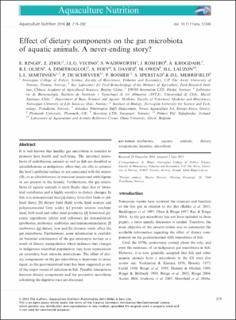Effect of dietary components on the gut microbiota of aquatic animals. A never-ending story?
| dc.contributor.author | Ringø, Einar | |
| dc.contributor.author | Zhou, Zhigang | |
| dc.contributor.author | Vecino, Jose L. González | |
| dc.contributor.author | Wadsworth, Simon L. | |
| dc.contributor.author | Romero, Jaime | |
| dc.contributor.author | Krogdahl, Åshild | |
| dc.contributor.author | Olsen, Rolf Erik | |
| dc.contributor.author | Dimitroglou, Arkadios | |
| dc.contributor.author | Foey, Andrew David | |
| dc.contributor.author | Davies, Simon | |
| dc.contributor.author | Owen, Matthew A.G. | |
| dc.contributor.author | Lauzon, Hélène Liette | |
| dc.contributor.author | Martinsen, Lisbeth Løvmo | |
| dc.contributor.author | De Schryver, Peter | |
| dc.contributor.author | Bossier, Peter | |
| dc.contributor.author | Sperstad, Sigmund | |
| dc.contributor.author | Merrifield, Daniel Lee | |
| dc.date.accessioned | 2022-05-03T09:23:59Z | |
| dc.date.available | 2022-05-03T09:23:59Z | |
| dc.date.created | 2016-07-19T08:47:15Z | |
| dc.date.issued | 2015 | |
| dc.identifier.citation | Aquaculture Nutrition. 2016, 22 (2), 219-282. | en_US |
| dc.identifier.issn | 1353-5773 | |
| dc.identifier.uri | https://hdl.handle.net/11250/2993831 | |
| dc.description.abstract | It is well known that healthy gut microbiota is essential to promote host health and well-being. The intestinal microbiota of endothermic animals as well as fish are classified as autochthonous or indigenous, when they are able to colonize the host's epithelial surface or are associated with the microvilli, or as allochthonous or transient (associated with digesta or are present in the lumen). Furthermore, the gut microbiota of aquatic animals is more fluidic than that of terrestrial vertebrates and is highly sensitive to dietary changes. In fish, it is demonstrated that [a] dietary form (live feeds or pelleted diets), [b] dietary lipid (lipid levels, lipid sources and polyunsaturated fatty acids), [c] protein sources (soybean meal, krill meal and other meal products), [d] functional glycomic ingredients (chitin and cellulose), [e] nutraceuticals (probiotics, prebiotics, synbiotics and immunostimulants), [f] antibiotics, [g] dietary iron and [h] chromic oxide affect the gut microbiota. Furthermore, some information is available on bacterial colonization of the gut enterocyte surface as a result of dietary manipulation which indicates that changes in indigenous microbial populations may have repercussion on secondary host–microbe interactions. The effect of dietary components on the gut microbiota is important to investigate, as the gastrointestinal tract has been suggested as one of the major routes of infection in fish. Possible interactions between dietary components and the protective microbiota colonizing the digestive tract are discussed. | en_US |
| dc.language.iso | eng | en_US |
| dc.publisher | Wiley | en_US |
| dc.rights | Navngivelse-Ikkekommersiell 4.0 Internasjonal | * |
| dc.rights.uri | http://creativecommons.org/licenses/by-nc/4.0/deed.no | * |
| dc.title | Effect of dietary components on the gut microbiota of aquatic animals. A never-ending story? | en_US |
| dc.title.alternative | Effect of dietary components on the gut microbiota of aquatic animals. A never-ending story? | en_US |
| dc.type | Peer reviewed | en_US |
| dc.type | Journal article | en_US |
| dc.description.version | publishedVersion | en_US |
| dc.source.pagenumber | 219-282 | en_US |
| dc.source.volume | 22 | en_US |
| dc.source.journal | Aquaculture Nutrition | en_US |
| dc.source.issue | 2 | en_US |
| dc.identifier.doi | 10.1111/anu.12346 | |
| dc.identifier.cristin | 1368521 | |
| cristin.ispublished | true | |
| cristin.fulltext | original | |
| cristin.qualitycode | 1 |
Tilhørende fil(er)
Denne innførselen finnes i følgende samling(er)
-
Institutt for biologi [2604]
-
Publikasjoner fra CRIStin - NTNU [38484]

